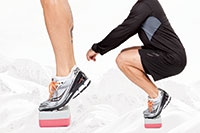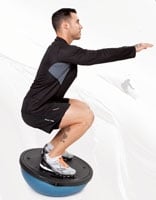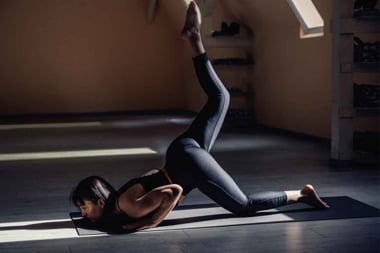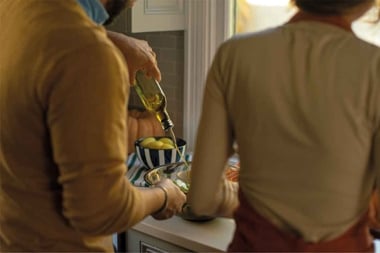
Watching the Olympics stirs our patriotism and maybe even a desire to get off the couch. We may not all be Olympians, but we can embrace our own inner athlete.
On a February afternoon in 1964, I was in geography class with an atlas open to the map of Austria. The Olympics were in Innsbruck, and I was calculating the opportune time to excuse myself to go to the janitor’s office. He had a black and white portable television permanently set on channel 11 for Wide World of Sports. I arrived just in time for the men’s downhill ski event. Egon Zimmermann, the young Austrian skier, took off from the gate. He resembled a low-flying rocket as he won gold.
I felt my inner athlete emerge through the excitement of that historic run. I felt the need to get stronger, get faster, and get myself to a gym. As I cried tears of pride, I witnessed something special.
I felt the same feelings of pride through each subsequent Olympiad, culminating with the Vancouver 2010 Winter Olympics. The floor in front of my television became stained with all the tears of pride and joy I squirted.
Olympic inspiration
I noticed that I worked out harder during the Olympics. Either I was trying to work off the stress of all those emotional outbursts or I was motivated to be better by all the athletic excellence I witnessed. I also noticed that more participants showed up for my exercise classes. After classes, they hung around the community centres to watch the events on television.
“It’s good to watch the Olympics with people,” one participant said while changing her shoes in the television room. “It makes it seem like you’re there. I cry too much when I watch alone.”
I think the upcoming Olympics in Sochi will be no exception. All autumn I witnessed record numbers coming to my fitness classes. The scuttlebutt is that they’re preparing for the ski season. I actually believe they’re getting ready to attempt to mimic some of the feats they’ll witness on television this February. In other words, they’re secretly awakening their inner Olympian.
Not just couch potatoes
Research supports this theory. A 2012 study determined that frequent sports spectators are more likely to exhibit personality traits such as extroversion and excitement seeking. In their spare time, they also participate in complementary activities such as playing sports and video games, and exercising. Watching sports makes the viewer want to participate.
If you’re a weekend athlete inspired by the Olympics to spend a little more time on the slopes, try out the half-pipe, or hurtle yourself off the end of a 90-metre ski jump, here are a few exercises to add to your fitness routine. Even if you don’t make the team, they might keep you from getting hurt too badly.
“Train, don’t strain” is my motto for training athletes for any event. Many Winter Olympic sports involve all the muscles of the legs and the core, as well as our general balance. Try to incorporate these in your regular workouts.
Remember, if a muscle hurts after using it, it’s one that should have been trained beforehand.
It’s never too late
You might think that the Olympics are just for younger competitors. Think again. Clara Hughes is one of only a handful of athletes to have podium finishes in both the Winter Olympics (long track speed skating) and Summer Olympics (cycling). By age 39, she brought home enough metal to open a foundry.
Other older Canadian Olympians include
- recently retired triathlete Simon Whitfield, age 38
- sailors Tyler Bjorn, age 43, and Richard Clarke, age 45
- equestrian show jumper Ian Millar, age 66
Internationally, there have been several older athletes:
- 64-year-old shooter Oscar Swahn of Sweden won a gold medal at the 1912 Summer Olympics, and he competed in the 1920 Summer Olympics when he was 72.
- 69-year-old equestrian Louis, Count du Douet de Graville, of France competed in the 1900 Summer Olympics.
- 70-year-old equestrian Hiroshi Hoketsu of Japan was the oldest Olympic athlete to compete at the 2012 Summer Olympics.
- 72-year-old Arthur von Pongracz of Austria competed in dressage in the 1936 Olympics.
The legs
Dry Land Whip Kick

Muscles worked: the inner thigh (the adductors and the gracilis), the quadriceps on the front of the thigh, the hamstrings at the back of the thigh, and the calf muscles
Sport benefits: These will let you skate backward and carve flawless figures, plus help keep your legs together on that giant slalom course.
Technique:
- Lie on your back. Lift your legs and feet straight up in the air, keeping them parallel and at 90 degrees to your hips.
- Squeeze your feet together as you bend your knees to the sides, then extend your legs upward so the knees are straight again. Do 10 of these on each side.
- Then bend your knees while together, and press them out and in—again, squeezing your feet together. Do 10 of these.
- Repeat both positions for 3 sets. Vary the speed of both exercises.
- Stretch the muscles by allowing your legs to fall to the side and relax.
Lunges

Muscles worked: an excellent exercise for the quadriceps; lunges also help improve balance
Sport benefits: This will give you strong thighs to make excellent times in short and long track speed skating without falling over.
Technique:
- Stand with the legs hip width apart.
- Lunge one leg backward so it’s just above the ground without touching, and come down until your forward thigh is bent parallel to the floor.
- Alternate legs with each lunge.
- Do 3 sets of 10 lunges for each leg.
- Add light hand weights as you get used to the exercise.
Be sure to stretch after you’ve finished:
- Lie on your side with your knees stacked on each other.
- Hold the top leg by the ankle and pull your heel toward your buttocks.
- Press your ankle against your hand as you rotate your hip forward and hold for 30 seconds.
- Repeat on the other side.
Hamstring Lift

Muscles worked: the hamstrings (the muscles at the back of the thigh)
Sport benefits: You’ll be ready for those cross-country ski trails and to perfect those flips on the half-pipe.
Technique:
- Use a large exercise ball.
- Lie on your back on the floor with your heels resting on the ball.
- Press your heels down so your butt lifts off the floor.
- Feel your hamstrings tightening as you do so.
- Do 3 sets of 10.
- Then perform 2 sets with only one heel on the ball, then change legs for 2 sets.
- Stretch the hamstrings separately by lying on your back and holding onto your shin while drawing the leg up to your chest.
Calf Raises

Muscles worked: the gastrocnemius and soleus, two important calf muscles
Sport benefits: You’ll be primed for a little speed skating and holding that delta position on the ski jump.
Technique:
- Stand on a step to exercise your calves.
- Hang your heels over the edge of the step, then lift them up for 3 sets of 10 repetitions.
- Split the sets up; do some with knees straight and some with knees bent at 90 degrees.
- Stretch these muscles by flexing your foot hard (works the soleus).
The core
The Swiss Chop

Muscles worked: important core muscles in the back and abdomen
Sport benefits: Soon you’ll have the core strength to steer down the skeleton run.
Technique:
- Lie on your back with the ball between your shoulder blades, feet flat on the floor, hands clasped together directly above your chest with elbows straight.
- Push your hands to the right side, hold for 3 seconds.
- Then push your hands to the left side and hold for 3 seconds.
- Hold a free weight to add resistance.
- Do 3 sets of 10 movements on each side.
Balance

Athletes have terrific balance. They train for better balance by challenging themselves to stand on different surfaces and make their bodies respond to changes in their centre of gravity. Superior balance means superior agility—and that benefits all sports!
Technique:
- Challenge yourself with a BOSU ball (an acronym for both sides up).
- Turn the apparatus so the dome side is down.
- Stand on the flat surface and feel your body respond.
- When you find your balance point, throw it off centre by doing a set of squats.
- Your balance will improve with time and practice, and you’ll look sharp on the half-pipe.




